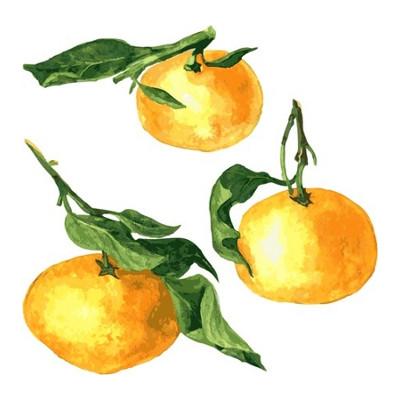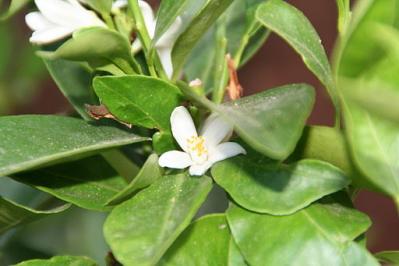Mandarins have their origin in China, native to the countries of South East Asia and the Philippines. The fruit spread through Asia and eventually in the 19th century to the Western world. Today it is cultivated in Mediterranean or subtropical climates around the globe.
Distribution, history and usage
The mandarin tree is a small, rounded citrus tree with slender, drooping branches and narrow, dark green leaves. Delicate, fragrant white blossoms appear in the Springtime that are either pollinated by insects or through apomixis.
There are several varieties of this fruit, including tangerines, a deep orange-red hybrid species originating from Tangier and the clementine from Algeria.
Mandarins have a yellow to orange coloured peel which can be removed easily, revealing the sweet, fleshy inner portions of the fruit.
The fruit was given its name to honour dignitaries of the Imperial Court, who dressed in orange hued ceremonial robes in China and is deemed a traditional symbol of good fortune and abundance. The Chinese words for mandarin sound like luck or wealth and their colour and shape suggests gold, money or the regenerative energy of the Sun; hence their ubiquitous presence as potted trees in doorways or entrances or as gifts in red envelopes, table displays or temple offerings during New Year.
Mandarins with the leaves intact are often placed in bowls in the home for the New Year as they are considered the fruits of happiness. There has to be an even number of fruit as uneven numbers denote unhappiness.
In Traditional Chinese Medicine and Ayuverda the bitter dried peel of the mandarin is used for digestive and gastrointestinal complaints or as an anti-catarrhal. Sun-dried mandarin or "chenpi" is also a common seasoning in Chinese cuisine.
Sweet and juicy fresh mandarins can be enjoyed on their own or used as an ingredient in salads, main dishes or desserts. Mandarin is a traditional flavouring for granitas in Italy.
Mandarin peel, either fresh, zested or dried, adds spice and tang to drinks, baked goods or candy.
Mandarin essential oil is a much loved oil used in aromatherapy for digestive, nervous system and circulatory applications. It is often found in natural skincare products for its skin softening and toning effects and in natural baby care products.
Essential oil production
Essential oil production of mandarin centres around the Italian island of Sicily but is also produced commercially in Brazil, Argentina, South Africa and from the mandarin growing regions of Queensland, New South Wales and Victoria in Australia.
Mandarin essential oil is obtained by cold expression of the pericarp or fruit wall. There are three kinds of essential oil - green, yellow and red, all derived from the same fruit but at different stages of maturity.
Unripe green fruits yield a light yellow essential oil, produced in Italy and South America, that is the preferred choice in perfumery. The next stage of maturity produces the yellow mandarin oil, primarily from Sicily, that is used in the flavour and fragrance industries. Chlorophyll, broken down by the acidic nature of the mandarin juice, deepens the yellow colour of the oil.
The mature red mandarin fruit yields the well known cold pressed red mandarin essential oil which is frequently used in aromatherapy and the natural cosmetics and flavour industries.
The chemical composition of each oil varies as does its aroma due to the different processing stages. Green mandarin oil is generally sharper and with more of a "peel" note compared to red mandarin. In perfumery it is employed in citrus accords, eau de colognes or to add lift and edge to floral blends.
A mandarin petitgrain essential oil is manufactured in Sicily by steam distillation, using the leaves and prunings of the tree.
In Australia mandarins were first introduced by the First Fleet, yet were not harvested commercially until the mid-1800's. Today they are the second largest citrus harvest after oranges. Mandarin trees start growing fruit after three years and reach full maturity at six years. The production cycle can continue for up to twenty years in a well maintained and irrigated orchard.
Cooler temperatures in Autumn and Winter are necessary for fruit development and ripening. The fruit is harvested in Winter and separated into two grades - one is used in the whole food industry and the other for juicing and essential oil extraction.

The mandarins are first cleaned before being extracted of their juice, while the ripe outer peel is mixed with water and processed through cold press extraction. This oil and water mixture is then further processed and centrifuged to separate the vibrantly coloured essential oil.
Roughly 700 to 800 kg of mandarin fruit is needed to produce one kilo of essential oil. At the same time around 400 kg of fresh juice is also extracted.
Red mandarin aromatic profile
Red mandarin essential oil is a bright, reddish-orange liquid. Its aroma is described as intense, fresh, sweet, fruity, juicy, sharp, tangy with elements of candied orange and a delicate floral, neroli-like undertone.
The main volatile constituents of mandarin essential oil are monoterpenes, including limonene at 60 to 70 %, gamma terpinene at 15 to 20 % and alpha and beta pinene, lending to its fresh, sweet citrus character. The oil is also composed of smaller amounts of alcohols and fatty aldehydes and trace amounts of thymol and methyl anthranilate, which contribute to its scent.
Anthranilates are nitrogen containing aromatic compounds which impart floral and fruity notes found in the essential oil, however they can also give a fishy top note to the oil as they undergo change.
Mandarin functions as a top note in an essential oil blend or aromatic composition. It has an immediate yet short-lived impact, infusing a mix with sparkle, energy and cheer.
It blends favourably with spice and other citrus oils, neroli, petitgrain, basil, roman chamomile, clary sage, frankincense, myrrh, lavender, palmarosa, geranium, juniper, cypress, patchouli, sandalwood, rose, ylang ylang, jasmine, ho wood and leaf, sweet marjoram and benzoin.
Scentcillo Starlet essential oil blend includes Australian cold pressed red mandarin essential oil, enticing you with its playful and sunny aroma.

Essential oil tip:
Citrus essential oils in particular are very prone to oxidation as they contain a high percentage of limonene. This can affect the integrity, consistency and aroma of the essential oil, so make sure, especially with your citrus oils, that they don't get over heated or are left with their caps off when not being used. In very hot climates or during Summer,store your citrus oils in a container, box or plastic bag in the refrigerator to maximise freshness.
Further reading
- Tea-scented mandarins. Eating Well.
- Mandarin liqueur. Hunter Distillery, Pokolbin.
- Mandarins in caramel sauce. Bite.
- Analytical characterization of mandarin (Citrus deliciosa Ten.) essential oil. Wiley Online Library.
- Three new components found in the non-volatile component of Sicilian mandarin essential oil which may be applied in identifying quality parameters.
- Genuineness assessment of mandarin essential oils employing gas chromatography-combustion-isotope ratio MS (GC-C-IRMS). Wiley Online Library.
- Assessment of authenticity of several mandarin essential oils characterized by different harvest periods and geographic origins.



















